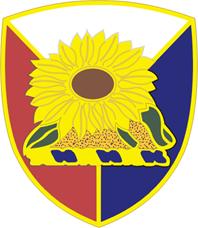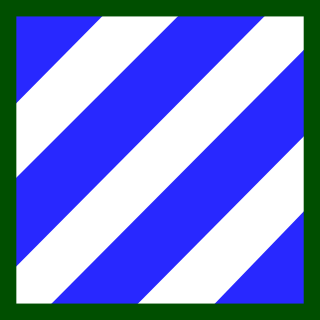
The 35th Infantry Division, formerly known as the 35th Division, is an infantry formation of the United States Army National Guard headquartered at Fort Leavenworth, Kansas.

The 27th Infantry Division was a unit of the Army National Guard in World War I and World War II. The division traces its history from the New York Division, formed originally in 1908. The 6th Division designation was changed to the 27th Division in July 1917.

The brigade combat team (BCT) is the basic deployable unit of maneuver in the U.S. Army. A brigade combat team consists of one combat arms branch maneuver brigade, and its assigned support and fire units. A brigade is normally commanded by a colonel (O-6) although in some cases a brigadier general (O-7) may assume command. A brigade combat team contains combat support and combat service support units necessary to sustain its operations. BCTs contain organic artillery training and support, received from the parent division artillery (DIVARTY). There are three types of brigade combat teams: infantry, Stryker, and armored.

The 32nd Infantry Brigade Combat Team is an infantry brigade combat team (IBCT) in the United States Army National Guard. It was formed from the inactivated 32nd Infantry Division in 1967. It is the largest unit in the Wisconsin National Guard.

The New York Army National Guard is a component of the New York National Guard and the Army National Guard. Nationwide, the Army National Guard comprises approximately one half of the United States Army's available combat forces and approximately one third of its support organization. National coordination of various state National Guard units are maintained through the National Guard Bureau.

The Kansas Army National Guard is a component of the Army National Guard and the Kansas National Guard. Kansas Army National Guard units are trained and equipped as part of the United States Army. The same ranks and insignia are used and National Guardsmen are eligible to receive all United States military awards. The Kansas Guard also bestows a number of state awards for local services rendered in or to the state of Kansas. It is, along with the Kansas Air National Guard, an element of the Kansas National Guard.

The 50th Armored Division was a division of the Army National Guard from July 1946 until 1993.

The Georgia Army National Guard is the Army National Guard component of the Georgia National Guard, administratively part of the Georgia Department of Defense. It consists of more than 11,100 citizen-soldiers training in more than 79 hometown armories and regional facilities across the state. Georgia’s Army Guard is the sixth largest in the nation and includes combat, combat support and combat service support units.

The 27th Infantry Brigade Combat Team ("Empire") is an infantry brigade combat team of the New York Army National Guard, one of the brigades that make up the 42nd Infantry Division.

The 48th Infantry Brigade Combat Team is a modular infantry brigade of the Georgia Army National Guard. One of the oldest units in U.S. Army history, the lineage of the 48th Infantry Brigade can be traced back to 1825. It is one of few units in the US military that also saw service as a unit of the Confederate States of America during the American Civil War. Today, the 48th IBCT is part of the U.S. Army's "Associated Units" program where it is aligned under the 3rd Infantry Division, a combined arms combat maneuver unit of the Regular Army.

The 75th Field Artillery Brigade is an artillery brigade in the United States Army. It is currently based in Fort Sill, Oklahoma and supports the III Armored Corps. The brigade is officially tasked to train and prepares for combat; on orders deploys to any area of operations to plan, synchronize and execute combined, and joint fires and effects. Integrate attached ground and air maneuver forces and on order function as a maneuver headquarters in support of full spectrum operations.

The 40th Armored Division was a division of the United States Army National Guard from July 1954 until 1967.
The Central Army Group (CENTAG) was a NATO military formation comprising four Army Corps from two NATO member nations comprising troops from Canada, West Germany and the United States. During the Cold War, CENTAG was NATO's forward defence in the southern half of the Federal Republic of Germany (FRG). The northern half of the FRG was defended by the four Army Corps of NATO's Northern Army Group (NORTHAG). During wartime, CENTAG would command four frontline corps. Air support was provided by Fourth Allied Tactical Air Force.

This page is about the 101st Cavalry Regiment. The 101st Cavalry Group was its headquarters unit.

The 1st Armored Division Artillery (DIVARTY) is the divisional artillery command for the 1st Armored Division at Fort Bliss, Texas. The DIVARTY has served with the division in World War II and the first Persian Gulf War, and in peacetime at Fort Hood, Fort Bliss, Fort Polk and Germany. The DIVARTY was inactivated in 2007 as part of transformation to modular brigade combat teams, but was reactivated in 2014 to provide fire support coordination and mission command for the training and readiness of field artillery units across the division.

The 2nd Infantry Division Artillery (DIVARTY) or "Warrior Strike" is the Force Field Artillery Headquarters for the 2nd Infantry Division. The DIVARTY served with the division from 1917 to present, including combat service in World War I, World War II, and the Korean War. In addition to peacetime service with the division at Fort Lewis, Washington, Fort Benning, Georgia, and in Japan and Alaska, the DIVARTY spent 40 years in Korea. After seven years stationed at Joint Base Lewis–McChord, where the DIVARTY provided fire support coordination and mission command for the training and readiness of five field artillery battalions, the Army restationed the DIVARTY to Camp Humphreys on 16 September 2021.

The 205th Engineer Battalion is an engineer battalion of the Louisiana Army National Guard. It is part of one of the 225th Engineer Brigade, one of largest engineer brigades in the United States Army National Guard. The 205th Engineer Battalion is headquartered in Bogalusa, LA in Washington Parish with the remaining companies and detachments located in St. Tammany, Tangipahoa, Ascension, and Jefferson parishes. The battalion provides command and control to plan integrate, and direct execution of three to five assigned engineer companies and one Forward Support Company (FSC) to provide mobility in support application or focused logistics.

















